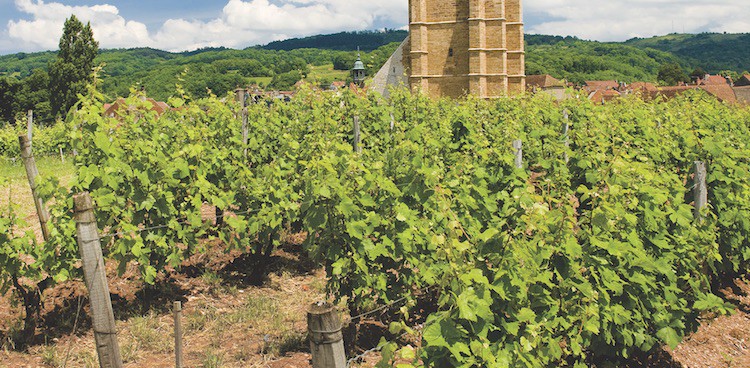
High in the hills between France and Switzerland, the Jura region has gained worldwide fame for Comté, a dense, aged cow’s milk cheese. What fewer know is that Jurassiennes also make some of the most curd-friendly wines in the world.
While the area is small and most of its wineries produce only enough for the locals to drink, the bottles that do make it to our shores are worth seeking out. The sommelier community has flipped out over vin jaune (“yellow wine”) and savagnin sous voile, two regional whites that gain their curious flavors from aging in barrels under a voile(“veil”) of yeast.
In summertime, however, the Jura’s most revelatory pours might be its reds, which skew brisker and lighter than the aforementioned whites—and they’re especially refreshing with a slight chill.
Jura red wines are a passion of Severine Perru, a French native who stocks plenty of them as wine director at The Ten Bells, a wine bar on Manhattan’s Lower East Side. “Poulsard—it goes with everything!” she says. “There’s even a saying in French: When you don’t know what to drink, drink poulsard.”
Sometimes spelled “ploussard,” this light red carries more flavor than its pale color implies, with peppery hints of spice, herbs, and earth mingling with red-berry tartness. Perru suggests seeking out Domaine de la Pinte, which, like many Jura wines, is made according to biodynamic principles (but in large enough quantity that you can actually find it).
Trousseau grapes, meanwhile, tend to yield wines that are a bit darker. They have “a little more depth and red fruit character, a little more richness,” Perru explains. Yet they’re never heavy. “There’s [a trousseau from Domaine de l’] Octavin—just pure, great juice, very light color, and with no added sulfur,” she says, mentioning one of the most delicate takes on the grape. “Or La Loue’s Pourquoi Pas?, which spends a little time in barrels and is a touch smoky.” Domaine Tissot also offers several cuvées, which range from ethereal to richly fruity.
Finally there’s Macvin, which is made by boiling down fresh grape juice, fortifying it with brandy, then aging the blend in barrels for years—a centuries-old local tradition. “Normally, we drink it as an aperitif,” Perru says. “Or a digestif.” Then she laughs, adding, “Actually, we drink it all the time. All we do is drink and eat.”
She pours a small glass of Domaine Tissot Macvin made from pinot noir, another common red-wine grape in Jura. It’s warming but not heavy, with an earthy, tangy, black-cherry sweetness; it practically cries out for blue cheese. Perru simmers it with agar-agar to make gelée for cheese plates.
When asked for other favorite Jura red-and-cheese pairings, Perru professes no real preference; she finds the wines so easy to pair that an exact match really doesn’t matter. “It’s shocking to the rest of France, but in Jura, we’ll often start with a fortified wine, then go to a red, then a clear, crisp white—they are all super easy to pair,” she says. “That’s what comes with wines that have acidity and transparency.”
And while they may have the acidity to stand up to the milky density of local Comté, many of Jura’s lighter reds are delicate enough to pair well with fresh summer curds. Open a bottle and settle in for a no-cook dinner of olive oil–drizzled burrata and crusty bread or a salad with citrusy chèvre.
Five to Try
Domaine de la Pinte 2014 Arbois Poulsard
Domaine de la Tournelle 2015 Arbois l’Uva Arbosiana Poulsard
Domaine Tissot 2015 Arbois Vieilles Vignes Poulsard
Domaine de l’Octavin 2015 Arbois Corvée de Trousseau
Domaine de la Loue 2014 Pourquoi Pas? Trousseau
Feature Photo Credit: PHb.cz (Richard Semik)/Shutterstock.com




